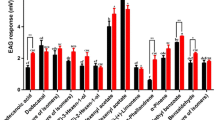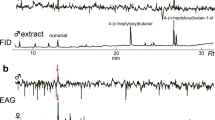Abstract
The tea aphid, Toxoptera aurantii, also called the “black citrus aphid”, is one of the most destructive insect pests in commercial tea plantations and gardens in southern China. In autumn, declining day length triggers production of winged T. aurantii sexuparae, which produce both winged males and wingless oviparae. Oviparous females then release sex pheromone that attracts potential mates. GC–MS analysis of volatile headspace extracts of T. aurantii oviparae revealed that they emit (4aS,7S,7aR)-nepetalactone (I) and (1R,4aS,7S,7aR)-nepetalactol (II) in a ratio of 4.3–4.9:1. Field-trapping experiments with synthetic I and II singly or as two-component blends of different doses and ratios showed significant attraction of T. aurantii males, as well as weak attraction of sexuparae. Identification of the T. aurantii sex pheromone provides a new opportunity for developing a pheromone-based monitoring and management strategy for the sexual phase of tea aphids and, possibly, the alate sexparous generation in late summer and fall.






Similar content being viewed by others
References
Agarwala B, Bhattacharya S (1995) Seasonal abundance in the black citrus aphid Toxoptera aurantii in North-East India: role of temperature. Proc Indian Nat Sci Acad Part B 61:377–382
Birkett MA, Pickett JA (2003) Aphid sex pheromones: from discovery to commercial production. Phytochemistry 62:651–656
Boo K, Choi M, Chung I, Eastop V, Pickett J, Wadhams L, Woodcock C (2000) Sex pheromone of the peach aphid, Tuberocephalus momonis, and optimal blends for trapping males and females in the field. J Chem Ecol 26:601–609
Boo KS, Kang SS, Park JH, Pickett JA, Wadhams LJ (2003) Field trapping of Chrysopa cognata (Neuroptera: Chrysopidae) with aphid sex pheromone components in Korea. J Asia-Pacific Entomol 6:29–36
Campbell C, Dawson G, Griffiths D, Pettersson J, Pickett J, Wadhams L, Woodcock C (1990) Sex attractant pheromone of damson-hop aphid Phorodon humuli (Homoptera, Aphididae). J Chem Ecol 16:3455–3465
Campbell CA, Cook FJ, Pickett JA, Pope TW, Wadhams LJ, Woodcock CM (2003) Responses of the aphids Phorodon humuli and Rhopalosiphum padi to sex pheromone stereochemistry in the field. J Chem Ecol 29:2225–2234
Carver M (1978) The black citrus aphids, Toxoptera citricidus (Kirkaldy) and T. aurantii (Boyer de Fonscolombe) (Homoptera: Aphididae). Aust J Entomol 17:263–270
Chauhan KR, Zhang A (2008) Methods of separating ZE-nepetalactone and EZ-nepetalactone from catnip oil. US Patent 7,375,239
Chauhan KR, Zhang Q-H, Aldrich JR (2004) Iridodials: enantiospecific synthesis and stereochemical assignment of the pheromone for the golden-eyed lacewing, Chrysopa oculata. Tetrahedron Lett 45:3339–3340
Dawson G, Griffiths D, Merritt L, Mudd A, Pickett J, Wadhams L, Woodcock C (1990) Aphid semiochemicals—a review, and recent advances on the sex pheromone. J Chem Ecol 16:3019–3030
Dewhirst SY, Birkett MA, Fitzgerald JD, Stewart-Jones A, Wadhams LJ, Woodcock CM, Hardie J, Pickett JA (2008) Dolichodial: a new aphid sex pheromone component? J Chem Ecol 34:1575–1583
Fernández-Grandon GM, Woodcock CM, Poppy GM (2013) Do asexual morphs of the peach-potato aphid, Myzus persicae, utilise the aphid sex pheromone? Behavioural and electrophysiological responses of M. persicae virginoparae to (4aS,7S,7aR)-nepetalactone and its effect on aphid performance. Bull Entomol Res 103:466–472
Goldansaz SH, Dewhirst S, Birkett MA, Hooper AM, Smiley DW, Pickett JA, Wadhams L, McNeil JN (2004) Identification of two sex pheromone components of the potato aphid, Macrosiphum euphorbiae (Thomas). J Chem Ecol 30:819–834
Guldemond JA, Dixon A, Pickett J, Wadhams L, Woodcock C (1993) Specificity of sex pheromones, the role of host plant odour in the olfactory attraction of males, and mate recognition in the aphid Cryptomyzus. Physiol Entomol 18:137–143
Han B-Y, Chen Z-M (2000) Behavior response of four Leis axyridis varieties to volatiles from tea and Toxoptera aurantii. Chin J Appl Ecol 11:413–416
Han B-Y, Chen Z-M (2002a) Behavioral and electrophysiological responses of natural enemies to synomones from tea shoots and kairomones from tea aphids, Toxoptera aurantii. J Chem Ecol 28:2203–2219
Han B-Y, Chen Z-M (2002b) Composition of the volatiles from intact and mechanically pierced tea aphid-tea shoot complexes and their attraction to natural enemies of the tea aphid. J Agric Food Chem 50:2571–2575
Han B-Y, Chen Z-M (2002c) Composition of the volatiles from intact and tea aphid-damaged tea shoots and their allurement to several natural enemies of the tea aphid. J Appl Entomol 126:497–500
Han B-Y, Han B-H (2007) EAG and behavioral responses of the wingless tea aphid, Toxoptera aurantii (Homoptera: Aphididae) to tea plant volatiles. Acta Ecol Sin 27:4485–4490
Han B-Y, Zhou C-S (2004) Attracting effect of volatile infochemicals from tea shoots and flowers on winged tea aphids. J Tea Sci 4:249–254
Han B-Y, Zhang Q-H, Byers JA (2012) Attraction of the tea aphid, Toxoptera aurantii, to combinations of volatiles and colors related to tea plants. Entomol Exp App 144:258–269
Hardie J, Holyoak M, Nicholas J, Nottingham SF, Pickett JA, Wadhams LJ, Woodcock CM (1990) Aphid sex pheromone components: age-dependent release by females and species-specific male response. Chemoecol 1:63–68
Hardie J, Visser J, Piron P (1994) Perception of volatiles associated with sex and food by different adult forms of the black bean aphid, Aphis fabae. Physiol Entomol 19:278–284
Hardie J, Storer JR, Cook FJ, Campbell CA, Wadhams LJ, Lilley R, Peace L (1996) Sex pheromone and visual trap interactions in mate location strategies and aggregation by host-alternating aphids in the field. Physiol Entomol 21:97–106
Hooper AM, Donato B, Woodcock CM, Park JH, Paul RL, Boo KS, Hardie J, Pickett JA (2002) Characterization of (1R,4S,4aR,7S,7aR)-dihydronepetalactol as a semiochemical for lacewings, including Chrysopa spp. and Peyerimhoffina gracilis. J Chem Ecol 28:849–864
Jeon H, Han KS, Boo KS (2003) Sex pheromone of Aphis spiraecola (Homoptera: Aphididae): composition and circadian rhythm in release. J Asia-Pacific Entomol 6:159–165
Koczor S, Szentkiralyi F, Birkett MA, Pickett JA, Voigt E, Tóth M (2010) Attraction of Chrysoperla carnea complex and Chrysopa spp. lacewings (Neuroptera: Chrysopidae) to aphid sex pheromone components and a synthetic blend of floral compounds in Hungary. Pest Manag Sci 66:1374–1379
Leroy PD, Schillings T, Farmakidis J, Heuskin S, Lognay G, Verheggen FJ, Brostaux Y, Haubruge E, Francis F (2012) Testing semiochemicals from aphid, plant and conspecific: attraction of Harmonia axyridis. Insect Sci 19:372–382
Lilley R, Hardie J (1996) Cereal aphid responses to sex pheromones and host-plant odours in the laboratory. Physiol Entomol 21:304–308
Lösel PM, Lindemann M, Scherkenbeck J, Campbell CA, Hardie J, Pickett JA, Wadhams LJ (1996a) Effect of primary host kairomones on the attractiveness of the hop-aphid sex pheromone to Phorodon humuli males and gynoparae. Entomol Exp Appl 80:79–82
Lösel PM, Lindemann M, Scherkenbeck J, Maier J, Engelhard B, Campbell CA, Hardie J, Pickett JA, Wadhams LJ, Elbert A (1996b) The potential of semiochemicals for control of Phorodon humuli (Homoptera: Aphididae). Pestic Sci 48:293–303
Park KC, Hardie J (2002) Functional specialisation and polyphenism in aphid olfactory sensilla. J Insect Physiol 48:527–535
Peng RK (1986) Study on bionomics and control of the black citrus aphid, Toxoptera aurantii. J Tea Bus 3:18–22
Pickett J, Wadhams L, Woodcock C, Hardie J (1992) The chemical ecology of aphids. Ann Rev Entomol 37:67–90
Pickett JA, Allemann RK, Birkett MA (2013) The semiochemistry of aphids. Nat Prod Rep 30:1277–1283
Powell G, Hardie J (2001) The chemical ecology of aphid host alternation: how do return migrants find the primary host plant? Appl Entomol Zool 36:259–267
Powell W, Pickett JA (2003) Manipulation of parasitoids for aphid pest management: progress and prospects. Pest Manag Sci 59:149–155
Stewart-Jones A, Dewhirst SY, Durrant L, Fitzgerald JD, Hardie J, Hooper AM, Pickett JA, Poppy GM (2007) Structure, ratios and patterns of release in the sex pheromone of an aphid, Dysaphis plantaginea. J Exp Biol 210:4335–4344
Symmes EJ, Dewhirst SY, Birkett MA, Campbell CA, Chamberlain K, Pickett JA, Zalom FG (2012) The sex pheromones of mealy plum (Hyalopterus pruni) and leaf-curl plum (Brachycaudus helichrysi) aphids: identification and field trapping of male and gynoparous aphids in prune orchards. J Chem Ecol 38:576–583
Zhang GX, Zhong TS (1983) Economic insects in China: Homoptera, Aphids. Science, China
Zhang Q-H, Sheng M, Chen G, Aldrich JR, Chauhan KR (2006) Iridodial: a powerful attractant for the green lacewing, Chrysopa septempunctata (Neuroptera: Chrysopidae). Naturwissenschaften 93:461–465
Zhu J, Zhang A, Park K-C, Baker T, Lang B, Jurenka R, Obrycki JJ, Graves WR, Pickett J, Smiley D (2006) Sex pheromone of the soybean aphid, Aphis glycines Matsumura, and its potential use in semiochemical-based control. Environ Entomol 35:249–257
Acknowledgments
This research was supported by a Grant (20130432B10) from the Research Foundation of Hangzhou City, Zhejiang Province, China, and a Grant (SOL 2010/714) from Solidaridad Foundation of the Netherland. We thank Dr. Jeffrey Aldrich (Jeffrey R. Aldrich consulting, LLC, Santa Cruz, CA) for valuable comments and suggestions on an earlier version of this manuscript.
Author information
Authors and Affiliations
Corresponding author
Additional information
Handling Editor: Paulo H. G. Zarbin.
Rights and permissions
About this article
Cite this article
Han, BY., Wang, MX., Zheng, YC. et al. Sex pheromone of the tea aphid, Toxoptera aurantii (Boyer de Fonscolombe) (Hemiptera: Aphididae). Chemoecology 24, 179–187 (2014). https://doi.org/10.1007/s00049-014-0161-6
Received:
Accepted:
Published:
Issue Date:
DOI: https://doi.org/10.1007/s00049-014-0161-6




